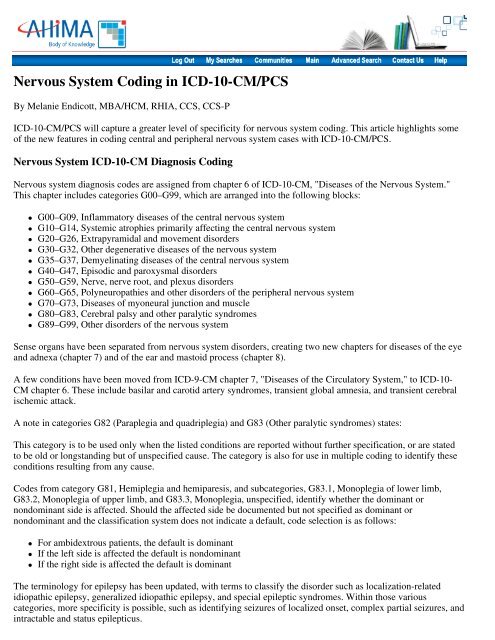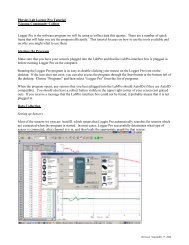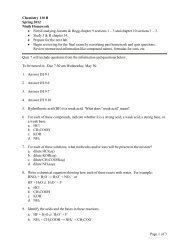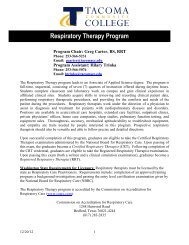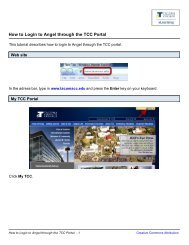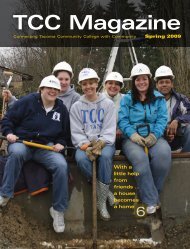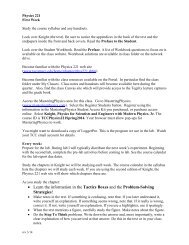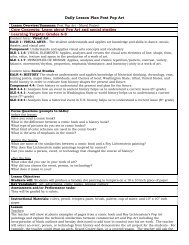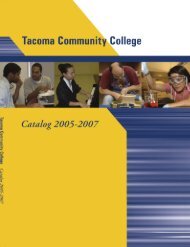Nervous System Coding in ICD-10-CM/PCS
Nervous System Coding in ICD-10-CM/PCS
Nervous System Coding in ICD-10-CM/PCS
You also want an ePaper? Increase the reach of your titles
YUMPU automatically turns print PDFs into web optimized ePapers that Google loves.
<strong>Nervous</strong> <strong>System</strong> <strong>Cod<strong>in</strong>g</strong> <strong>in</strong> <strong>ICD</strong>-<strong>10</strong>-<strong>CM</strong>/<strong>PCS</strong><br />
By Melanie Endicott, MBA/H<strong>CM</strong>, RHIA, CCS, CCS-P<br />
<strong>ICD</strong>-<strong>10</strong>-<strong>CM</strong>/<strong>PCS</strong> will capture a greater level of specificity for nervous system cod<strong>in</strong>g. This article highlights some<br />
of the new features <strong>in</strong> cod<strong>in</strong>g central and peripheral nervous system cases with <strong>ICD</strong>-<strong>10</strong>-<strong>CM</strong>/<strong>PCS</strong>.<br />
<strong>Nervous</strong> <strong>System</strong> <strong>ICD</strong>-<strong>10</strong>-<strong>CM</strong> Diagnosis <strong>Cod<strong>in</strong>g</strong><br />
<strong>Nervous</strong> system diagnosis codes are assigned from chapter 6 of <strong>ICD</strong>-<strong>10</strong>-<strong>CM</strong>, "Diseases of the <strong>Nervous</strong> <strong>System</strong>."<br />
This chapter <strong>in</strong>cludes categories G00–G99, which are arranged <strong>in</strong>to the follow<strong>in</strong>g blocks:<br />
<br />
<br />
<br />
<br />
<br />
<br />
<br />
<br />
<br />
<br />
<br />
G00–G09, Inflammatory diseases of the central nervous system<br />
G<strong>10</strong>–G14, <strong>System</strong>ic atrophies primarily affect<strong>in</strong>g the central nervous system<br />
G20–G26, Extrapyramidal and movement disorders<br />
G30–G32, Other degenerative diseases of the nervous system<br />
G35–G37, Demyel<strong>in</strong>at<strong>in</strong>g diseases of the central nervous system<br />
G40–G47, Episodic and paroxysmal disorders<br />
G50–G59, Nerve, nerve root, and plexus disorders<br />
G60–G65, Polyneuropathies and other disorders of the peripheral nervous system<br />
G70–G73, Diseases of myoneural junction and muscle<br />
G80–G83, Cerebral palsy and other paralytic syndromes<br />
G89–G99, Other disorders of the nervous system<br />
Sense organs have been separated from nervous system disorders, creat<strong>in</strong>g two new chapters for diseases of the eye<br />
and adnexa (chapter 7) and of the ear and mastoid process (chapter 8).<br />
A few conditions have been moved from <strong>ICD</strong>-9-<strong>CM</strong> chapter 7, "Diseases of the Circulatory <strong>System</strong>," to <strong>ICD</strong>-<strong>10</strong>-<br />
<strong>CM</strong> chapter 6. These <strong>in</strong>clude basilar and carotid artery syndromes, transient global amnesia, and transient cerebral<br />
ischemic attack.<br />
A note <strong>in</strong> categories G82 (Paraplegia and quadriplegia) and G83 (Other paralytic syndromes) states:<br />
This category is to be used only when the listed conditions are reported without further specification, or are stated<br />
to be old or longstand<strong>in</strong>g but of unspecified cause. The category is also for use <strong>in</strong> multiple cod<strong>in</strong>g to identify these<br />
conditions result<strong>in</strong>g from any cause.<br />
Codes from category G81, Hemiplegia and hemiparesis, and subcategories, G83.1, Monoplegia of lower limb,<br />
G83.2, Monoplegia of upper limb, and G83.3, Monoplegia, unspecified, identify whether the dom<strong>in</strong>ant or<br />
nondom<strong>in</strong>ant side is affected. Should the affected side be documented but not specified as dom<strong>in</strong>ant or<br />
nondom<strong>in</strong>ant and the classification system does not <strong>in</strong>dicate a default, code selection is as follows:<br />
<br />
<br />
<br />
For ambidextrous patients, the default is dom<strong>in</strong>ant<br />
If the left side is affected the default is nondom<strong>in</strong>ant<br />
If the right side is affected the default is dom<strong>in</strong>ant<br />
The term<strong>in</strong>ology for epilepsy has been updated, with terms to classify the disorder such as localization-related<br />
idiopathic epilepsy, generalized idiopathic epilepsy, and special epileptic syndromes. With<strong>in</strong> those various<br />
categories, more specificity is possible, such as identify<strong>in</strong>g seizures of localized onset, complex partial seizures, and<br />
<strong>in</strong>tractable and status epilepticus.
A note <strong>in</strong> categories G40, Epilepsy and recurrent seizures, and G43, Migra<strong>in</strong>e, notes that the terms<br />
pharmacoresistent (pharmacologically resistant), treatment resistant, refractory (medically), and poorly<br />
controlled are considered equivalent to <strong>in</strong>tractable.<br />
Seven Characters of a Medical and Surgical Code<br />
Character 1<br />
Character 2<br />
Character 3<br />
Character 4<br />
Character 5<br />
Character 6<br />
Character 7<br />
Section<br />
Body <strong>System</strong><br />
Root Operation<br />
Body Part<br />
Approach<br />
Device<br />
Qualifier<br />
Root Operations of the Central and Peripheral <strong>Nervous</strong> <strong>System</strong><br />
There are 20 root operations relevant to the central and peripheral nervous system. Coders should<br />
beg<strong>in</strong> familiariz<strong>in</strong>g themselves with the root operations and their def<strong>in</strong>itions to prepare for cod<strong>in</strong>g <strong>in</strong><br />
<strong>ICD</strong>-<strong>10</strong>-<strong>PCS</strong>.<br />
Root<br />
Operation<br />
Bypass (1)<br />
Change (2)<br />
Destruction (5)<br />
Division (8)<br />
Dra<strong>in</strong>age (9)<br />
Excision (B)<br />
Def<strong>in</strong>ition<br />
Alter<strong>in</strong>g the route of passage of the contents of a tubular body part<br />
Tak<strong>in</strong>g out or off a device from a body part and putt<strong>in</strong>g back an identical or similar<br />
device <strong>in</strong> or on the same body part without cutt<strong>in</strong>g or punctur<strong>in</strong>g the sk<strong>in</strong> or a<br />
mucous membrane<br />
Physical eradication of all or a portion of a body part by the direct use of energy,<br />
force, or a destructive agent<br />
Cutt<strong>in</strong>g <strong>in</strong>to a body part, without dra<strong>in</strong><strong>in</strong>g fluids and/or gases from the body part,<br />
<strong>in</strong> order to separate or transect a body part<br />
Tak<strong>in</strong>g or lett<strong>in</strong>g out fluids and/or gases from a body part<br />
Cutt<strong>in</strong>g out or off, without replacement, a portion of a body part<br />
Extirpation (C) Tak<strong>in</strong>g or cutt<strong>in</strong>g out solid matter from a body part<br />
Extraction (D)<br />
Fragmentation<br />
(F)<br />
Insertion (H)<br />
Inspection (J)<br />
Map (K)<br />
Release (N)<br />
Removal (P)<br />
Repair (Q)<br />
Reposition (S)<br />
Resection (T)<br />
Pull<strong>in</strong>g or stripp<strong>in</strong>g out or off all or a portion of a body part by the use of force<br />
Break<strong>in</strong>g solid matter <strong>in</strong> a body part <strong>in</strong>to pieces<br />
Putt<strong>in</strong>g <strong>in</strong> a nonbiological appliance that monitors, assists, performs, or prevents a<br />
physiological function but does not physically take the place of a body part<br />
Visually and/or manually explor<strong>in</strong>g a body part<br />
Locat<strong>in</strong>g the route of passage of electrical impulses and/or locat<strong>in</strong>g functional<br />
areas <strong>in</strong> a body part<br />
Free<strong>in</strong>g a body part from an abnormal physical constra<strong>in</strong>t<br />
Tak<strong>in</strong>g out or off a device from a body part<br />
Restor<strong>in</strong>g, to the extent possible, a body part to its normal anatomic structure and<br />
function<br />
Mov<strong>in</strong>g to its normal location, or other suitable location, all or a portion of a body<br />
part<br />
Cutt<strong>in</strong>g out or off, without replacement, all of a body part<br />
Putt<strong>in</strong>g <strong>in</strong> or on biological or synthetic material that physically re<strong>in</strong>forces and/or
Supplement (U) augments the function of a portion of a body part<br />
Revision (W)<br />
Transfer (X)<br />
Correct<strong>in</strong>g, to the extent possible, a portion of a malfunction<strong>in</strong>g device or the<br />
position of a displaced device<br />
Mov<strong>in</strong>g, without tak<strong>in</strong>g out, all or a portion of a body part to another location to<br />
take over the function of all or a portion of a body part<br />
<strong>Nervous</strong> <strong>System</strong> Procedure <strong>Cod<strong>in</strong>g</strong> <strong>in</strong> <strong>ICD</strong>-<strong>10</strong>-<strong>PCS</strong><br />
The central and peripheral nervous system are found <strong>in</strong> the medical and surgical section of <strong>ICD</strong>-<strong>10</strong>-<strong>PCS</strong>. All <strong>ICD</strong>-<br />
<strong>10</strong>-<strong>PCS</strong> codes are seven characters long with each of the seven characters represent<strong>in</strong>g an aspect of the procedure.<br />
The diagram at left illustrates the seven characters of a code from the medical and surgical section.<br />
Medical and surgical codes have a first character of "0." The second character for the central nervous system is "0,"<br />
while the second character for the peripheral nervous system is "1."<br />
There are 20 root operations relevant to the central and peripheral nervous system, def<strong>in</strong>ed <strong>in</strong> the table on above.<br />
Coders should beg<strong>in</strong> familiariz<strong>in</strong>g themselves with the root operations and their def<strong>in</strong>itions to prepare for <strong>ICD</strong>-<strong>10</strong>-<br />
<strong>PCS</strong>.<br />
The body part values (fourth character) <strong>in</strong> the central and peripheral nervous system are numerous. The body part<br />
key <strong>in</strong> <strong>ICD</strong>-<strong>10</strong>-<strong>PCS</strong> is a table that lists each body part and its correspond<strong>in</strong>g anatomical structures. Coders should<br />
become familiar with the body part key <strong>in</strong> learn<strong>in</strong>g to accurately assign <strong>ICD</strong>-<strong>10</strong>-<strong>PCS</strong> codes.<br />
For <strong>in</strong>stance, if a physician documents a neurolysis of the celiac plexus, which is not one of the listed body parts <strong>in</strong><br />
the peripheral nervous system, coders can reference the body part key to identify the celiac plexus as a branch of the<br />
abdom<strong>in</strong>al sympathetic nerve.<br />
The fifth character specifies approach (i.e., open, via natural or artificial open<strong>in</strong>g), and the sixth character <strong>in</strong>dicates<br />
devices, such as a dra<strong>in</strong>age device. The seventh and last character is a qualifier, which is specific to a particular root<br />
operation. The seventh character may be used to specify the dest<strong>in</strong>ation of a bypass (e.g., atrium, ur<strong>in</strong>ary tract), a<br />
diagnostic procedure (e.g., biopsy), or the site receiv<strong>in</strong>g a nerve transfer (e.g., optic nerve, facial nerve).<br />
Examples of procedures performed on the central and peripheral nervous system are revision of a VP shunt<br />
(00W600Z), percutaneous radiofrequency coagulation of the trigem<strong>in</strong>al nerve (005K3ZZ), sutur<strong>in</strong>g of the ulnar<br />
nerve (01Q40ZZ), left carpal tunnel release (01N50ZZ), and sever<strong>in</strong>g of the sciatic nerve via percutaneous<br />
endoscopic approach (018F4ZZ).<br />
References<br />
AHIMA. "CATS <strong>ICD</strong>-<strong>10</strong>-<strong>PCS</strong> A&P Focus: Central and Peripheral <strong>Nervous</strong> <strong>System</strong>s Course." Available for<br />
purchase at www.ahimastore.org.<br />
Centers for Medicare and Medicaid Services. "2011 <strong>ICD</strong>-<strong>10</strong>-<strong>PCS</strong>." www.cms.gov/icd<strong>10</strong>.<br />
National Center for Health Statistics. "2011 <strong>ICD</strong>-<strong>10</strong>-<strong>CM</strong> Official Guidel<strong>in</strong>es for <strong>Cod<strong>in</strong>g</strong> and Report<strong>in</strong>g."<br />
www.cdc.gov/nchs/icd/icd<strong>10</strong>cm.htm.<br />
National Center for Health Statistics. "2011 <strong>ICD</strong>-<strong>10</strong>-<strong>CM</strong>." www.cdc.gov/nchs/icd/icd<strong>10</strong>cm.htm.<br />
Melanie Endicott (melanie.endicott@ahima.org) is a professional practice resource specialist at AHIMA.
Article citation:<br />
Endicott, Melanie. "<strong>Nervous</strong> <strong>System</strong> <strong>Cod<strong>in</strong>g</strong> <strong>in</strong> <strong>ICD</strong>-<strong>10</strong>-<strong>CM</strong>/<strong>PCS</strong>." Journal of AHIMA 82, no.6<br />
(June 2011): 62-64.<br />
Copyright ©2011 American Health Information Management Association. All rights reserved. All contents, <strong>in</strong>clud<strong>in</strong>g images and<br />
graphics, on this Web site are copyrighted by AHIMA unless otherwise noted. You must obta<strong>in</strong> permission to reproduce any<br />
<strong>in</strong>formation, graphics, or images from this site. You do not need to obta<strong>in</strong> permission to cite, reference, or briefly quote this material<br />
as long as proper citation of the source of the <strong>in</strong>formation is made. Please contact Publications to obta<strong>in</strong> permission. Please <strong>in</strong>clude the<br />
title and URL of the content you wish to repr<strong>in</strong>t <strong>in</strong> your request.


